A few days back, when I went to get my book on dreams for Photo Friday, I realized how disorganized that bookcase was. The books range from philosophy to religion, anatomy, various body and energy work modalities, aromatherapy, feng shui and space clearing, animal totems and guides, crystals and stones, astrology, and several Tarot decks and books, as well as other decks like oracle and relaxation cards, and a set of rune stones with their book. It’s eclectic and reflects many of my interests and activities through the decades.

I took some time to put everything in better order and to shift some of the Tarot decks between the boxes where they’re stored. I decided to take this lovely deck that I’ve had since 1990, The Enchanted Tarot, and put it in my Dennis Box, wrapped in a different fabric.
The Dennis Box is one I painted around 1990, the same year I got the deck. This is why it has that name: the inside of the top of the box. It offers a bit of Muse magic.
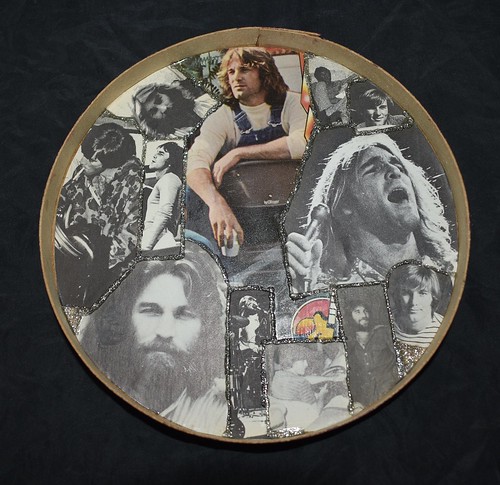
Here’s the inside of the box, and the back of the cards, though they are kept wrapped in a piece of black silk, the edges hemmed with gold thread, that was donated to me by Lynne in the early ’90s from a favorite old shirt of hers.
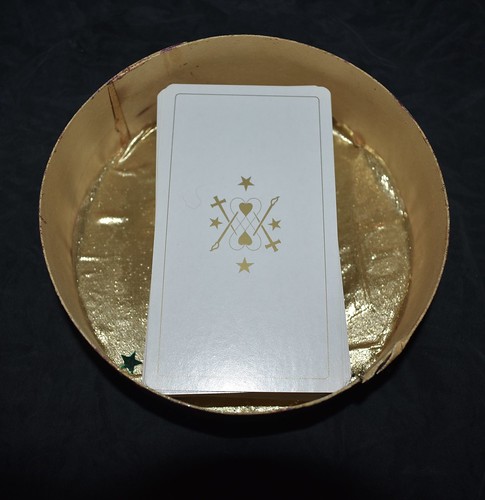
Here’s a partial look at the top of the box with a card I pulled this evening in a one-card reading looking for specific guidance on a specific question I was thinking about.
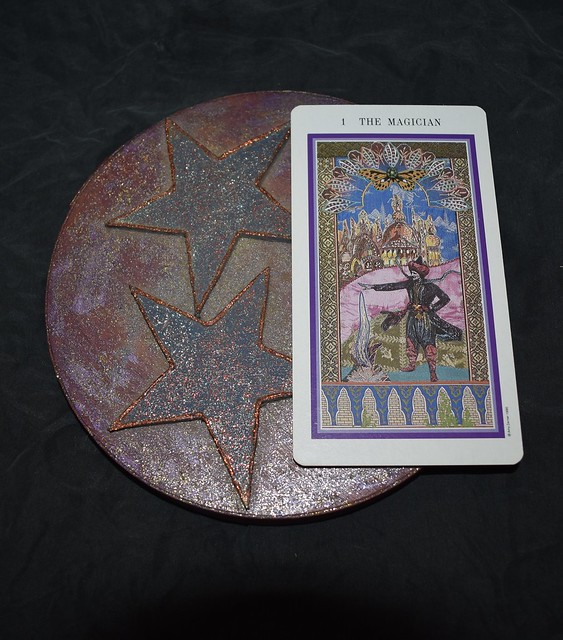
This was an extremely helpful card for this reading, a major arcana card chosen at random from a full, face-down deck after I shuffled it.
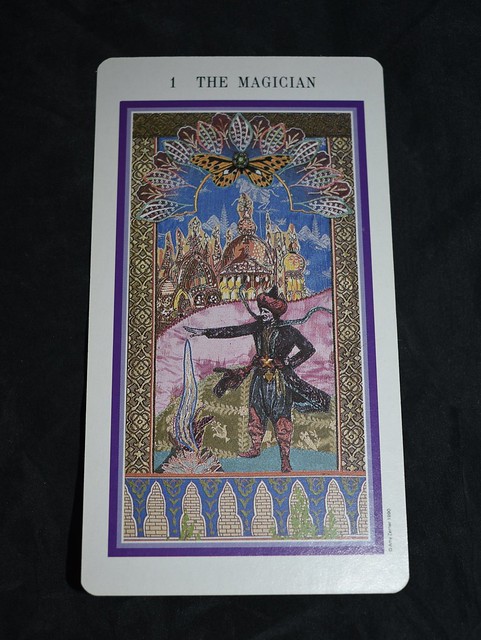
The Enchanted Tarot is described by its creators as a story of hope and faith born of the truth of the human spirit eternally seeking to know itself and its power. It’s meant to help the reader or questioner gain insight into the workings of the world and how to best harmonize with it [one’s] activities of both a spiritual and physical kind.
Each card in the deck has a description in the book broken into The Dream, The Awakening, and The Enchantment. For The Enchantment, I followed very specific instructions at the end of the reading using the following items:

The card, with items representing the four elements: a white candle, a cup of water, a crystal (I chose amethyst), and a knife (a beautiful old knife that belonged to my father) were placed on a red cloth, and I used a stick of incense to complete the enchantment. This has nothing to do with trying to control the future (it is not spell-casting, for example, which I have never done and will never do) or even to predict the future. It’s a means to feel confident in the card’s description and the path forward I want to set.
As a creative person putting a lot of energy into what I’m working on, I can always use more confidence. This was a quiet, reflective time well spent.
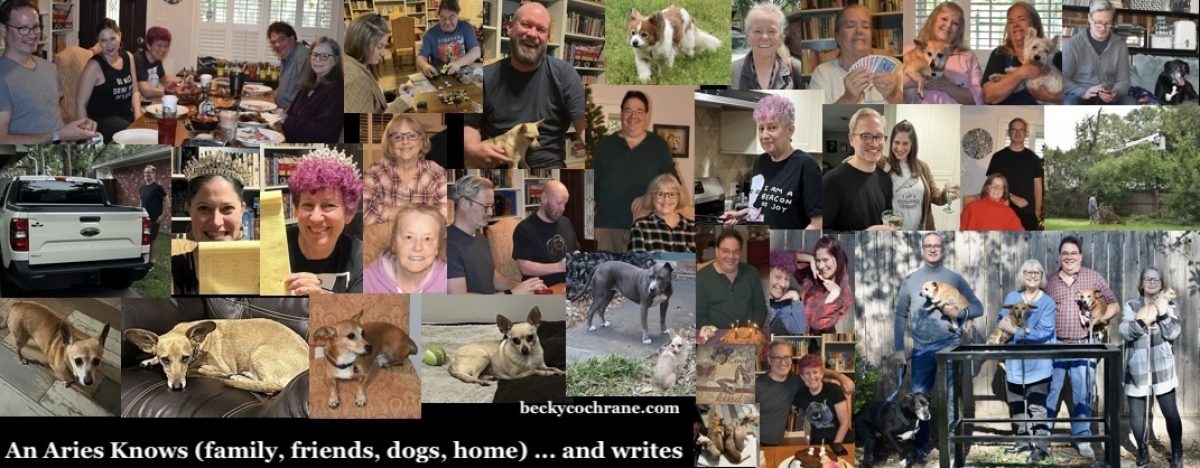
I can’t remember the last time I used my Tarot deck. I should give the cards a shuffle.
So how does an enchantment differ from a spell?
This could be my perspective on semantics… The book calls that part of the reading “enchantment,” a word that I think has a lot of connotations, including the idea of spell casting, and when I brought it up, it seemed important to communicate I don’t do that. If casting spells is meant to control or manipulate someone else’s behavior or an outcome using magic, that’s not something I’d ever do or try to do. I see Tarot as a means of self-examination–feelings, hopes, dreams, barriers, challenges–and choosing a course of action that’s healthy, not harmful, for the self (or for anyone).
It’s a big topic! If you wanted to suggest an example of what a person might want from any of the things I mentioned (Tarot, crystals, or aromatherapy, for example), I’d happily tackle it with specifics in another post.
My query arose from the use of the four items representing the four elements. What is their purpose? Purely symbolic? I possess a lot of curiosity around this sort of thing.
It’s kind of delightful to say that the couple who created this deck, Amy Zerner and Monte Farber, have been married for 47 years and have kept up their business through the pandemic (they are already used to working from home) to develop books and an oracle deck to help people deal with the specific challenges of the pandemic.
She created all the tapestries that are pictured on the cards of the Enchanted Tarot, and thanks to you, I’ve thoroughly enjoyed researching her art and the two of them, in general. Since she will express it more accurately than I can, here’s a section from a 2011 interview I found, with Amy discussing the three parts of a reading that includes Enchantment:
The use of The Enchanted Tarot involves a novel three-fold approach. Each card possesses its own special power derived from ‘The Dream’, ‘The Awakening’ and ‘The Enchantment’ levels of consciousness.
– The Dream is the gentle fable that reveals the fabric of each card’s allegorical meaning by weaving a tale explaining the action and symbols portrayed. The Dream entertains as it penetrates the psyche to fulfill the card’s intention. Over time repeated reading of each of The Dreams will expose deeper levels of meaning, as repeated viewing of the cards of The Enchanted Tarot will produce new insights into their purposeful design.
In each of the seventy-eight Dreams, both the twenty-two cards of the Major Arcana, as well as the fifty-six cards comprising the four suits of Minor Arcana each correspond to an archetypal dream experience. They are engaging fantasies that speak directly to our subconscious mind.
– The Awakening brings the lesson of each story into our conscious mind for evaluation and assimilation so it may be used as a tool for guidance and personal growth. It is a straight-forward explanation of what each card signifies in a specific reading.
– The Enchantment is the link between our waking world and the land of dreams. The use of these healing rituals, charms, chants and spells reinforces our awareness of the existence of the magical world and remind us of our ability to draw on its power. The enchantments aid us in casting out our fears, drawing love and abundance to us, and healing emotional wounds.
For me personally, just one example of using one of the items that I picked for Enchantment is that knife that was in a box of my mother’s with several other knives. I feel certain it was my father’s because of its design–he brought many items home from his tours in Korea and trips through Japan, perhaps as souvenirs (like the dolls he brought me), but often because they had some connection to the people he met there. When a knife was called for (to represent swords), I checked that box of my mother’s and picked this one for several reasons. It connects me to my parents, so it feels like it offers protection, love, and guidance. It reminds me that we are all part of one world, as my father exemplifies for me a small-town Alabama boy growing up to have tours of duty on the European and Asian continents. And it reminds me that we all face battles we can survive with fortitude and courage without losing either our compassion for and responsibility to others.
While I can’t speak for how others use the tangible items (as she mentioned, in “healing rituals, charms, chants and spells”), I use them as a means of symbolizing and visualizing strength and perseverance in relation to the question I asked before my reading and the journey the answer may require of me. It particularly resonates with me that she talked (in that article) about casting out our fears and healing emotional wounds. Both of those things spoke directly to what I was asking about a path forward.
I know my answer’s long, but I love that you asked and wanted to put some thought into what I replied.